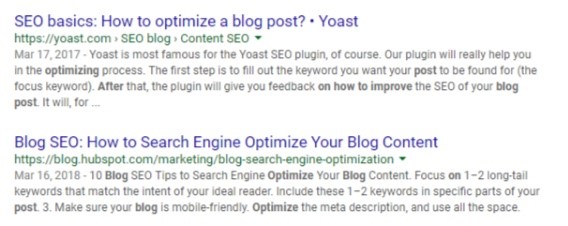I am writing this article on how to optimize a blog post because of a recent experience I had with a “big market” digital marketing agency. The owner of this agency sought me out on LinkedIn and approached me to interview for what I thought would be a short-term, project-oriented assignment. A previous employee had left them in a state of disarray when they discovered she had completed none of her assignments for three months.
 After I agreed to step in I did find that there were huge gaps in the posting of content on several client websites. The clients were signed up for a high-level of new content frequency coupled with SEO campaigns and monthly analytic reports. To my surprise, I discovered that even blog posts published up to 12 months past were not optimized at all. Then I saw pages on the websites were not properly optimized. When I asked about keyword strategies, I got blank faces.
After I agreed to step in I did find that there were huge gaps in the posting of content on several client websites. The clients were signed up for a high-level of new content frequency coupled with SEO campaigns and monthly analytic reports. To my surprise, I discovered that even blog posts published up to 12 months past were not optimized at all. Then I saw pages on the websites were not properly optimized. When I asked about keyword strategies, I got blank faces.
Lesson number one, ask very specific questions about how an agency or free-lancer approaches standard optimization and any SEO (search engine optimization) campaign. Not everyone really knows how to optimize a blog post properly. It is a science of sorts, but it is not rocket science.**
Number 1: How to Optimize a Blog Post with a Keyword
First and most importantly, each page or post on your website should have a primary focus for the search engines to identify and index for your ranking. If there are three different topics the search engine will not decide for you which is the most important. All three topics, or keywords, will rank lower than if they stood alone.
The keyword for this article is not a single word, but a phrase:” optimize a blog post.” I could even use, “how to optimize a blog post.” Your primary keyword should be a single word or a phrase that your ideal reader might actually use in a search. Single words are often far too competitive for a small business to attack head on, so I like to use “long-tail” phrases that are less competitive. This means they are less-frequently used in a search and therefore less competitive.
Even the “longer-tail” phrase “how to optimize a blog post” is highly competitive. When I tested it in Google I saw posts by big entities like Moz, Yoast, Hubspot, and Search Engine Land. Nevertheless, I persist.
Number 2: Create a Title and Sub-Headings
It’s not always easy or natural, but work your creative moxie to find an eye-catching way to use your keyword in the title of your article. This is the title in your URL for the page and an H1 header tag.
The tags are important because they speak the language of the crawlers (the bots, the spiders) that visit your website and report back to the search engine that sent them. You have another opportunity to use your keyword in at least one H2 tag as a sub-header or section title in your article. Scroll up a little and you will see how I used the “how to optimize a blog post” keyword in the H2 header for this section.
Number 3: Use the Keyword in the Text of Your Article
Using your keyword in the text of your article should be a pretty simple thing is that topic is exactly what you are writing about, right? Well, it is not always that easy.
This is what you need to do. Make sure you use your keyword in the first paragraph of the article and at least two times more. Depending on the length of the article you could maybe use it more. While there is no definite number or formula to use, we can use our common sense. If the article reads easily, clearly, and doesn’t sound like we have artificially “stuffed” the keyword in every possible place of usage, then we should be alight.
Honestly, I used the “how to optimize a blog post” so many times at the beginning of this article as an example, I am half-afraid I will get dinged by Google for stuffing. Luckily, I use the Yoast plugin for WordPress to measure this and several other aspects of blog optimization. I highly recommend both the free plug-in and the premium version.
Number 4: Craft Your Meta-description
Even on WordPress without an SEO plugin, there is a menu or box available for adding your won meta-description. If you do not add your own, Google will create one from content on hand elsewhere. Google might use the first paragraph or so of the post itself. We can’t control Google or any search engine, but we can make suggestions. And that is what a meta-description is. It is a suggested paragraph to use for identifying and indexing the post. It is also the paragraph we hope Google will place as the snippet under your link on the search results page.

The best meta-descriptions are written for your reader, not for Google. They clearly and quickly state the core topic and benefit to the reader of selecting this post to view. For the search engine’s sake, make sure you use your keyword in the meta-description closer to the start of it.
How long should your meta-description be? Google generally cuts your meta-description off at 300 characters and even shorter on mobile-based search results.
Remember that hot-shot agency that had promised optimization to their clients? None of their blog posts, going back for a year, had a proper meta-description. What I did see was the same paragraph placed in post after post. “The XXX Company based in Hometown, State is the leading producer of this great product serving the best people in town.” Generic, meaningless, and duplicate content that could get them penalized by Google. It was worse than having nothing there. Don’t do that!
Number 5: Tag Your Images
One of the easiest things to do and most frequently overlooked is the proper optimization of the images used in your blog posts. Whether the image is a featured header or used in the body of the post, size the image properly for easy loading and give it an alt tag that includes your keyword. This is easy to do in the WordPress Media Manager as you add the image to the page.
Number 6: Add Internal and External Links
Links are an important factor in the search engine ranking of your page. Sometimes as I am writing the post I see clear opportunities to place a link to an external website (external link.) You can see where I linked to Yoast as I praised its plug-in for SEO. I also linked to Moz, Hubspot, and SearchEngineLand. I do not have an affiliate relationship with any of these companies, but I think highly of them and want to give my readers an opportunity to learn more if they wish.
That is the point of internal and external links: to make it easy for your reader to learn more. A page with no links is considered a dead-end and will not win any points for being helpful.
I add my internal links after I’ve published the post. I can easily see that I will be linking some of the core SEO vocabulary to other posts I have written. My Yoast plug-in makes it even easier because it pulls up suggestions.
Number 7: Write for Your Reader
I confess that I have at times stated, “We write for the search engines.” It’s a reasonable mistake because when I am optimizing posts that others have written, that is exactly my focus. However, it is not the whole story.
You can be at the top of the rankings having used attractive keywords and descriptive copy that earns a click-through from the reader, but if the reader finds your copy boring, difficult to read, or not as informative as they desire, then you lose the reader. Google pays attention to “bounces”—when a visitor does not stay long on a page and does not take any action with a click.
Use the language and style that your ideal readers will respond to. Answer their questions and add value to their experience. Videos are ideal to keep a reader on your page, as are images and infographics that are meaningful.
Make your copy and format easy to scan and easy to read. We are all impatient and become even more so when we are reading on a mobile device.
If you have read this far, thank you. I hope that it was worth the time and maybe just a bit entertaining.
More to Life
 I grew up in central Florida on the east side of Orlando. Throughout the 1960’s we could look into the eastern skies from my backyard and watch the Apollo rockets launch into space. I was very young but had a keen eye for each stage of the launch and watched the news every time there was a countdown and space flight. It was a great time and place to be a curious child.
I grew up in central Florida on the east side of Orlando. Throughout the 1960’s we could look into the eastern skies from my backyard and watch the Apollo rockets launch into space. I was very young but had a keen eye for each stage of the launch and watched the news every time there was a countdown and space flight. It was a great time and place to be a curious child.
